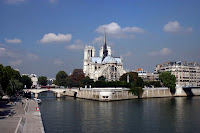This is the second time I have asked one of my blogging friends to write a post for me answering the phrase that headlines this space. Remember the first time? Each of us has a different reason, but as conversion is on-going (and not a "one and done event") each one of us must confront the reason as we make progress along the path of our individual pilgrimages.
So Pat, if I asked you to answer "Why I Am Catholic," what would you say?
Because of Church History, Not In Spite of It
by Pat McNamara
 |
| Perugino's The Delivery of the Keys |
For me personally, history has a lot to do it. Catholics are literally surrounded by it. In our churches, we worship amid statues, paintings, mosaics and stained glass windows that depict past people and events. We sing hymns written long ago, sometimes centuries. While there have been many changes in the post-Vatican II Church, there are more continuities than we credit it for.
I’ve never had a head for philosophy or theology, and apologetics aren’t among my gifts. But from early on, Church history has been in my blood. Years ago, I found a quote that has become my favorite, from an English Protestant historian named Thomas Babington Macaulay. I love to use it when teaching the subject:
 |
| St. Peters Basilica, Rome |
As Macaulay says, there’s never been anything like it in world history. For better or for worse, you can’t talk about the last two millennia without referencing it.
For Catholics, Church history is the story of God’s People in a particular time and in a particular place. That is to say, the fallible People of God. Take the words of Jean Baptiste Lacordaire (1802-1865), the French Dominican priest who was probably the greatest Catholic preacher of his time:
 |
| Notre Dame Cathedral, Paris |
Right from the night of the Last Supper, there have been low points in Church history. Often cited are the Crusades, the Inquisition, and Pope Pius XII’s “silence” during the Holocaust. But let’s take the Renaissance Papacy, now the subject of an HBO minseries. Historian Eamon Duffy writes of it:
The Renaissance papacy evokes images of a Hollywood spectacular, all decadence and drag. Contemporaries viewed Renaissance Rome as we now view Nixon’s Washington, a city of expense-account whores and political graft, where everything and everyone had a price, where nothing and nobody could be trusted. The popes themselves seemed to set the tone.
 |
| Our Lady of Angels, Los Angeles Tapestries by John Nava |
So there are high points and low points in Church history, but Catholics don’t see it as a meaningless cycle as the ancients did. In his City of God, St. Augustine explained the Christian understanding of history as linear, with a starting and ending point. As a Church, we have our ups and downs. We fall along the way. But we get up and move on toward our ultimate goal together. People create scandals, but God sends graces, and the people who respond to it we call saints.
History shows us, then, that we need not despair. There is hope. Father James Kent Stone, a 19th century American priest, wrote, “Yes, there have been scandals… if we look for them. But there have been saints and martyrs… of whom the world knows nothing. And there are saints still.” And though we are all fallible, from top to bottom, Jesus promised to remain with us until the end of time.
As people of faith, therefore, we have an obligation not to be discouraged, but to keep hope. For help is always in sight, and God’s grace is waiting for us to to respond. So for those of us who are discouraged by the current state of the Church, fear not. As Father Stone noted, the saints aren’t coming. They’re already here!
That’s why I am Catholic, and proud of it.
 |
| Inside St. Peters Basilica |

